Aragonese language facts for kids
Quick facts for kids Aragonese |
||||
|---|---|---|---|---|
| aragonés | ||||
| Native to | Spain | |||
| Region | Aragon; northern and central Huesca and northern Zaragoza | |||
| Ethnicity | Aragonese people | |||
| Native speakers | 25,500 (2011) including speakers living outside the native area (2011) | |||
| Language family |
Indo-European
|
|||
| Early forms: |
Navarro-Aragonese
|
|||
| Writing system | Latin (Aragonese alphabet) | |||
| Official status | ||||
| Regulated by | Academia d'a Luenga Aragonesa | |||
| Linguasphere | 51-AAA-d | |||

Map of Aragon with the dialects of northern Aragon in gray, blue, and light orange
|
||||
|
||||
The Aragonese language is a Romance language spoken in the north of Aragon, a region in Spain. About 10,000 people speak Aragonese today. It is sometimes called fabla, which means "talk" or "speech".
This language is part of the Romance language family. This means it comes from Latin, just like Spanish, French, and Italian. Aragonese is similar to other languages spoken nearby. These include Spanish, Catalan, and Occitan. You might also find some Aragonese words that sound like Basque words.
Contents
What is the Aragonese Language?
Aragonese is a special language with a long history. It developed in the Pyrenees mountains in the north of Aragon. For a long time, it was the main language of the Kingdom of Aragon.
Where is Aragonese Spoken Today?
Today, Aragonese is mostly spoken in the northern parts of Aragon. This includes areas in the Huesca province and the northern Zaragoza province. It is a minority language, meaning fewer people speak it compared to Spanish.
How is Aragonese Different from Spanish?
Even though Aragonese and Spanish are both Romance languages, they have some differences. Aragonese has kept some older sounds and words from Latin. It also has unique words that come from its mountain history. For example, Aragonese often uses the "ch" sound where Spanish uses "ll".
History of the Aragonese Language
The Aragonese language began to form around the 8th century. It grew from the Latin spoken by people in the Pyrenees. Over time, it became the official language of the Kingdom of Aragon.
The Golden Age of Aragonese
From the 12th to the 15th centuries, Aragonese was very important. It was used in official documents, literature, and everyday life. Famous writers like Johan Ferrández d'Heredia wrote in Aragonese.
Why Did Aragonese Decline?
After the 15th century, the importance of Aragonese started to fade. This happened for a few reasons. The marriage of Ferdinand II of Aragon and Isabella I of Castile united the kingdoms of Aragon and Castile. Spanish, which was the language of Castile, became more dominant. Many people started using Spanish instead of Aragonese.
Efforts to Protect Aragonese
Today, there are groups working to keep Aragonese alive. They teach the language in schools and create books and music in Aragonese. The Academia d'a Luenga Aragonesa is an official group that helps protect and promote the language. These efforts are important to make sure Aragonese continues to be spoken.
Images for kids
See also
 In Spanish: Idioma aragonés para niños
In Spanish: Idioma aragonés para niños



